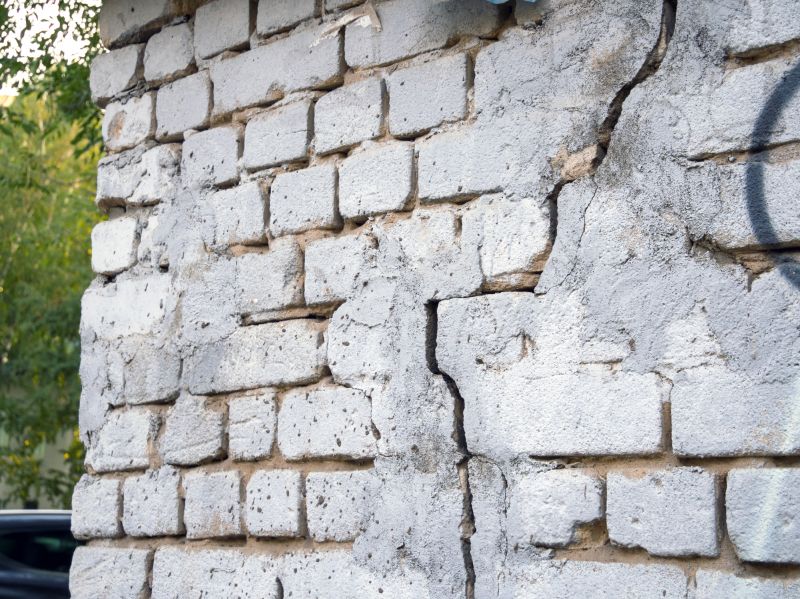Popular Tools And Materials For Fixing Bowed Walls You Can Trust
Discover essential products that professionals and DIY enthusiasts rely on for durable bowed wall repairs.
 Bowed walls can present significant structural concerns in residential and commercial buildings, often resulting from foundation settlement, soil pressure, or moisture issues. Addressing these problems requires selecting appropriate repair products that can stabilize and straighten affected walls. Repair methods may include installing wall anchors, braces, or reinforcement systems designed to counteract bowing and prevent further movement. The effectiveness of these solutions depends on the severity of the bowing, the type of wall material, and the underlying cause of the deformation.
Bowed walls can present significant structural concerns in residential and commercial buildings, often resulting from foundation settlement, soil pressure, or moisture issues. Addressing these problems requires selecting appropriate repair products that can stabilize and straighten affected walls. Repair methods may include installing wall anchors, braces, or reinforcement systems designed to counteract bowing and prevent further movement. The effectiveness of these solutions depends on the severity of the bowing, the type of wall material, and the underlying cause of the deformation.
Types of Products For Bowed Wall Repairs
Wall Anchor Kits
Includes anchors, rods, and plates for stabilizing bowed walls from the exterior.
Carbon Fiber Wall Reinforcement
High-strength carbon fiber strips designed to reinforce and straighten bowed walls internally.
Steel Wall Braces
Heavy-duty steel braces that provide immediate support to compromised walls.
Wall Reinforcing Plates
Metal plates that reinforce weak points and prevent further bowing.
Hydraulic Push Piers
Foundation support systems that lift and stabilize sinking or bowing walls.
Epoxy Injection Kits
Resin-based solutions for filling cracks and preventing water intrusion.
Wall Stabilization Cables
Cables used to secure and stabilize walls from internal or external attachment points.
Concrete Patching Compounds
Materials for repairing surface cracks and minor bowing issues in concrete walls.
Soil Stabilization Grouts
Injectable grouts that reinforce the soil surrounding foundation walls.
Foundation Repair Sleeves
Flexible sleeves that reinforce and support cracked or bowed sections of foundation walls.
Interior Wall Support Beams
Horizontal beams installed inside to provide direct support to compromised walls.
Exterior Wall Bracing
Support systems installed on the outside of the structure to prevent further bowing.
Flexible Wall Reinforcement Mesh
Mesh materials used to reinforce and stabilize wall surfaces prone to bowing.
Foundation Underpinning Systems
Supports that extend the foundation's depth to stabilize settling walls.
Structural Support Columns
Vertical supports used to transfer load and stabilize walls from beneath.
Popular Choices
Widely used for their adaptability and effectiveness in stabilizing bowed basement walls.
Popular for internal reinforcement due to its high strength-to-weight ratio.
Commonly selected for foundation stabilization and lifting applications.
Effective for providing immediate support in interior spaces with bowing issues.
Frequently used for crack sealing and minor structural repairs.
Chosen for their durability and ability to provide strong external support.
Selected for addressing significant settlement and foundation issues.
Used to improve soil conditions around foundations to prevent further movement.
Often incorporated into repair plans to transfer load and stabilize walls.
Popular for surface reinforcement and preventing further cracking.
Applied to provide external stabilization and prevent further bowing.
Commonly used for surface crack repairs and minor deformation corrections.
When considering products for bowed wall repairs, it's important to evaluate their compatibility with existing wall structures, ease of installation, and durability over time. Many repair systems are designed to be minimally invasive, allowing for effective stabilization without extensive demolition. Properly selected products can help restore wall alignment and improve overall structural integrity. Consulting with a structural engineer or foundation specialist can provide valuable insights into the most suitable options for specific situations.
In addition to structural reinforcement, some repair products also serve to waterproof and protect walls from future issues. Moisture management is crucial in preventing further deterioration and maintaining the longevity of the repair. Regular inspection and maintenance of repaired walls can help identify early signs of movement or damage, ensuring timely intervention. Choosing high-quality, versatile repair products can contribute to a safer, more stable environment in both residential and commercial settings.
Key Buying Considerations
- Severity of the bowing or cracking to determine appropriate repair method.
- Type of wall material (concrete, brick, block, etc.) and compatibility with repair products.
- Accessibility of the affected area for installation purposes.
- Potential for water intrusion and whether waterproofing measures are necessary.
- Long-term durability and resistance to environmental factors.
- Ease of installation, especially if DIY options are considered.
- Impact on the building's foundation and overall structural integrity.
- Need for professional assessment or engineering consultation before repair.
- Cost considerations and availability of repair components within budget.
- Compatibility with existing foundation or wall systems.
- Potential for future movement or settling that could affect repair longevity.
- Availability of warranties or guarantees from product manufacturers.
- Maintenance requirements for the repair system over time.
- Environmental conditions such as moisture, soil type, and climate influences.
- Local building codes and regulations related to structural repairs.
